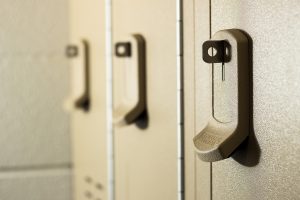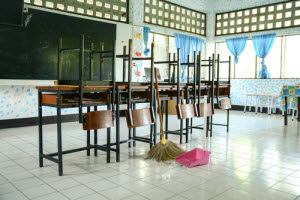As a facility manager of a school, you’ve got a lot to keep up with in terms of maintenance. However, one of the most important areas to focus on are the bathrooms in your school. There are a variety of factors that can contribute to the drop in quality of your bathrooms, but there are a few ways that you can stay ahead of the elements and keep your bathroom in great shape.
Factors That Affect Your School’s Bathrooms
The bathrooms in your school may be the most visited areas of the entire building, which means that you’ll need to stay on top of cleaning and maintenance to ensure that everyone walks away with a pleasant experience. However, the first step towards keeping your bathroom in great shape is identifying the factors that affect your school’s bathrooms.
- Unpleasant Odors. There are a few reasons why your bathroom has a distinct and unpleasant smell, but the first step is identifying where the smells are coming from before you initiate a plan to rid your restroom of these odors.
- Dirty Floors & Vanities. No one likes to see excessive dirt and crud on the floor, especially in the bathroom. Countertops and bathroom vanities are also known to collect dirt, so executing a thorough cleaning plan is important.
- Low Water Pressure. If your water pressure is low, it can add stress and aggravation to the bathroom experience. Be sure that the sink and toilet water pressure are up to your standards.
- Mold Growth. Over time, your bathroom will begin to sprout mold because the humidity and moisture create an environment where fungus thrives, and foul smells are present.
Execute a Heavy-Duty Cleaning & Maintenance Strategy
Make a plan to clean your school’s restroom vigorously on a regular basis—and not just sweeping the floor and throwing away any paper towels that didn’t quite make it into the trash. You’ll want some anti-bacterial cleaning products to meticulously clean the restroom. This can help combat the smells and bacteria that are growing. You’ll also want to regularly check your facility’s water pressure to be sure that the water in the sink and the toilet flushing are up to par.
Stop Mold in Its Tracks
 You’ll be able to spot mold sprouting in the corners of your bathroom, but that’s not the only place it can grow. Often, mold begins to sprout inside toilet partitions that have an inner core. The kraft paper interior stays moist due to the humidity in the bathroom. Over time, the mold will begin to take over. Once mold has grown inside these partitions, it’s difficult to clean and salvage the partitions.
You’ll be able to spot mold sprouting in the corners of your bathroom, but that’s not the only place it can grow. Often, mold begins to sprout inside toilet partitions that have an inner core. The kraft paper interior stays moist due to the humidity in the bathroom. Over time, the mold will begin to take over. Once mold has grown inside these partitions, it’s difficult to clean and salvage the partitions.
However, you can stay ahead of mold growth and put off on replacing your partitions repeatedly. Using HDPE plastic partitions can help ward off mold because this solid plastic doesn’t feature an inner core that can absorb moisture. Installing HDPE plastic partitions has a variety of benefits: they’re easy to clean, mold won’t grow, and they outlast most other materials.
Picking a Long-Lasting Solution
Having a solid plan to regularly maintain your bathrooms is important. You’ll want to take the necessary steps that you’re combatting the elements, preventing any mechanical issues, and warding off mold and bacteria. HDPE plastic partitions can aid you in a number of ways, from preventing mold growth within your stalls, reducing the foul odors, and having a material that can last a long time to stand up to the factors that affect your school’s restrooms.
Want to learn more about HDPE plastic partitions and how using the right materials can help you maintain your school’s bathrooms? Check out this eBook, Choosing Bathroom Materials, from your friends at Scranton Products.

 Students aren’t always gentle with the lockers in your school. In fact, they can sometimes be a bit rough. Most students choose slamming the locker shut as their preferred method of closing it, and over time, this can result in the locker door and frame becoming dented. Worst of all, this can cause the lockers to become less secure.
Students aren’t always gentle with the lockers in your school. In fact, they can sometimes be a bit rough. Most students choose slamming the locker shut as their preferred method of closing it, and over time, this can result in the locker door and frame becoming dented. Worst of all, this can cause the lockers to become less secure. When you notice the unsightly dents, you’ll want to fix them before they get worse. Take a rubber mallet, or a flat hammer, and with medium force, strike the dent. You should have a hard flat surface behind the opposite direction of the dent to ensure that the dent evens out. Using light to medium force, strike the dent a few times. It’ll start to flatten out and become more even with the locker’s surface. You’ll want to complete this action after school hours due to the loud noise that’s expected when hammering the locker—you won’t want student distraction to be an issue.
When you notice the unsightly dents, you’ll want to fix them before they get worse. Take a rubber mallet, or a flat hammer, and with medium force, strike the dent. You should have a hard flat surface behind the opposite direction of the dent to ensure that the dent evens out. Using light to medium force, strike the dent a few times. It’ll start to flatten out and become more even with the locker’s surface. You’ll want to complete this action after school hours due to the loud noise that’s expected when hammering the locker—you won’t want student distraction to be an issue. Now that you’ve got your time to paint, you need your place. Find an open area in the school that you can paint. It will allow you to have the room to paint multiple lockers, so you can start getting the job done. That way, you can reinstall the lockers quickly. You can paint the lockers where they stand, but you’ll need plenty of tarp or drop cloth coverage to prevent any paint from getting on the floor or the wall.
Now that you’ve got your time to paint, you need your place. Find an open area in the school that you can paint. It will allow you to have the room to paint multiple lockers, so you can start getting the job done. That way, you can reinstall the lockers quickly. You can paint the lockers where they stand, but you’ll need plenty of tarp or drop cloth coverage to prevent any paint from getting on the floor or the wall. Metal lockers are very durable and reliable storage compartments for the students. Sometimes, though, their maintenance, care, and upkeep outweigh their usefulness compared to plastic lockers. The constant maintenance and repainting certainly adds to the locker’s costs. What you need is a reliable locker that doesn’t require the constant upkeep while retaining its appearance and durability.
Metal lockers are very durable and reliable storage compartments for the students. Sometimes, though, their maintenance, care, and upkeep outweigh their usefulness compared to plastic lockers. The constant maintenance and repainting certainly adds to the locker’s costs. What you need is a reliable locker that doesn’t require the constant upkeep while retaining its appearance and durability. You may not really take the time to consider the variety of materials that can be used as toilet partitions. However, reviewing all of your options can allow you to make the best choice for your facility. Most toilet partitions are made from plastic with an inner core made from kraft paper or cardboard. Materials like Phenolic, Baked Enamel, and Plastic Laminate may look nice in your restroom, but they may be left vulnerable to the moisture and humidity in your restroom. The inner core will absorb the moisture, and over time, it’ll sprout mold, leading to a pungent odor and a substantial problem to solve.
You may not really take the time to consider the variety of materials that can be used as toilet partitions. However, reviewing all of your options can allow you to make the best choice for your facility. Most toilet partitions are made from plastic with an inner core made from kraft paper or cardboard. Materials like Phenolic, Baked Enamel, and Plastic Laminate may look nice in your restroom, but they may be left vulnerable to the moisture and humidity in your restroom. The inner core will absorb the moisture, and over time, it’ll sprout mold, leading to a pungent odor and a substantial problem to solve. A Material That Lasts
A Material That Lasts




 Be sure to check your air and water quality to see if it’s up to code. Find a water tester in the area to help you conduct these routine tests so you can see where the quality lies. If the result isn’t as high as you’d hoped, consider replacing the filtration system. When it comes to air, there are several ways that you can do your part increase the quality. Consider getting indoor plants, utilize
Be sure to check your air and water quality to see if it’s up to code. Find a water tester in the area to help you conduct these routine tests so you can see where the quality lies. If the result isn’t as high as you’d hoped, consider replacing the filtration system. When it comes to air, there are several ways that you can do your part increase the quality. Consider getting indoor plants, utilize  HDPE (high-density polyethylene) is a solid, strong plastic that has many applications when it comes to building materials. Some facility managers aren’t sure that HDPE provides a stronger construct than other plastics, but HDPE has been proven to be one of the more durable plastics on the market, making it a formidable opponent to other plastics that are available.
HDPE (high-density polyethylene) is a solid, strong plastic that has many applications when it comes to building materials. Some facility managers aren’t sure that HDPE provides a stronger construct than other plastics, but HDPE has been proven to be one of the more durable plastics on the market, making it a formidable opponent to other plastics that are available.